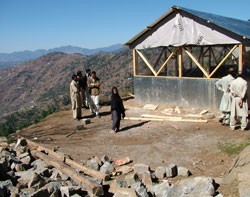
Challenge
In Bagh, a district in Pakistani-administered Kashmir, nearly 1500 school-children were killed when their classrooms collapsed during the devastating October 2005 earthquake. Tens of thousands of others were luckier — they survived and soon returned to schools set up in tents. They faced a challenging learning environment — different teachers, grade levels, and age groups were left with no choice but to share space in the same tent.
Initiative
To help meet the demand for temporary classrooms until school buildings could be rebuilt and to remove the rubble of collapsed schools that posed a safety hazard, USAID launched a training and cash-for-work program. First, master carpenters attended a four-day workshop where they learned about earthquake-resistant designs. They returned home to teach the techniques to other carpenters. Then, USAID paid carpenters $10 a day to build transitional earthquake-resistant classrooms of all sizes from wood and corrugated iron. USAID helped build 60 such classrooms for 45 schools. In addition, USAID paid villagers to sort through rubble that posed safety hazards to children coming and going from the temporary schools. They received tools, safety gear, and about $3 a day each to tear down severely damaged school structures and remove unsafe elements like sharp objects from the rubble.
Results
USAID helped build 60 such classrooms for 45 schools. In addition, 194 government schools in Bagh District received desks, chairs and blackboards. “Schools are very important to us, even more so than homes,” said Mohammed Saleem, one of five master carpenters who built structures for the boys middle school in Bees Bagla. “A whole generation will be destroyed if we don’t restore our schools,” he added. Shakil Ahmed, a science teacher, said he was grateful the classrooms would once again allow him to teach different grades in separate spaces. Working with the people of Bagh, USAID is helping students return to school and villagers rebuild a community.







Comment
Make a general inquiry or suggest an improvement.